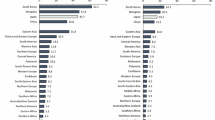Abstract
Recent reports in the United States have found that fewer peptic ulcers are due to Helicobacter pylori than previously believed. The aim of this study is to determine if the declining prevalence of H. pylori infection in the general population can account for the apparent increase in the frequency of non-H. pylori ulcers. A total of 396 patients with peptic ulcer or ulcer scar were enrolled in this study. The pre-1950 population consisted of 149 patients with gastric ulcers and with 44 duodenal ulcers. The post-1950 population consisted of 96 patients with gastric ulcers and 107 with duodenal ulcers. The frequency of H. pylori-negative gastric ulcers was 5.4% in patients born before 1950 and 4.2% in patients born after 1950, and the frequency of H. pylori-negative duodenal ulcers was 0% and 1.9%, respectively. There are no statistical differences between the two populations in gastric and duodenal ulcers. H. pylori seropositivity was 74.9% in asymptomatic volunteers born before 1950 and 20.7% in those born after 1950 (P < 0.01) in the general population. The attributable risk of H. pylori infection in peptic ulcer diseases was not affected by the prevalence of H. pylori infection in the general population in Japan. This suggests that the apparent increase in frequency of non-H. pylori ulcers in the United States is not simply due to the declining prevalence of infection. Other explanations for non-H. pylori ulcers should be sought.
Similar content being viewed by others
REFERENCES
Hopkins RJ, Girardi LS, Turney EA: Relationship between Helicobacter pylori eradication and reduced duodenal and gastric ulcer recurrence: A review. Gastroenterology 110:1244–1252, 1996
Marshall BJ: Helicobacter pylori. Am J Gastroenterol 89(suppl):116–128, 1994
Chan FKL, Sung JY, Chung SCS, Yung TMY, Leung VKS, Lee YT, Chan CSY, Li EKM, Woo J: Randomized trial of eradication of Helicobacter pylori before non-steroidal antiinflammatory drug therapy to prevent peptic ulcers. Lancet 350:975–979, 1997
Hawkey CJ, Tulassay Z, Szczepanski L, Rensburg CJ, Filipowicz-Sosnowska A, Lanas A, Wason CM, Peacick RA, Gillon KRW: Randomized controlled trial of Helicobacter pylori eradication in patients on non-steroidal anti-inflammatory drugs: HELP NSAIDs study. Lancet 352:1016–1021, 1998
Sprung DJ, Apter M, Allen B, Cook L, Allen B, Guarda L: The prevalence of Helicobacter pylori in duodenal ulcer diseases: A community based study. Am J Gastroenterol 91:1926 (A169), 1996
Jyotheeswaran S, Shah AN, Jin HO, Potter GD, Ona FV, Chey WY: Prevalence of Helicobacter pylori in peptic ulcer patients in greater Rochester, NY: Is empirical triple therapy justified? Am J Gastroenterol 93:574–578, 1998
Kurata JH, Nogawa AN: Meta-analysis of risk factors for peptic ulcer. Non-steroidal anti-inflammatory drugs, Helicobacter pylori and smoking. J Clin Gastroenterol 24:2–17, 1997
Schlemper RJ, van der Werf SD, Vandenbroucke JP, Biemond I, Lamers CB: Risk factors of peptic ulcer disease: Different impact of Helicobacter pylori in Dutch and Japanese populations? J Gastroenterol Hepatol 11:825–831, 1996
Asaka M, Kimura T, Kudo M, Takeda H, Mitani S, Miyazaki T, Miki K, Graham DY: Relationship of Helicobacter pylori to serum pepsinogens in an asymptomatic Japanese population. Gastroenterology 102:760–766, 1992
Chiba M, Ishii N, Ishioka T, Murata M, Masamune O, Sugiyama T, Yachi A: Topographic study of Helicobacter pylori and HLA-DR antigen expression on gastric epithelium. J Gastroenterol 30:149–155, 1995
Evans DJ, Evans DG, Graham DY, Klein PD: A sensitive and specific serologic test for detection of Campylobacter pylori infection. Gastroenterology 96:1004–1008, 1989
Ohara S, Kato M, Asaka M, Toyota T: Studies of [13C] urea breath test for diagnosis of Helicobacter pylori infection in Japan.J Gastroenterol 33:6–13, 1998
Author information
Authors and Affiliations
Rights and permissions
About this article
Cite this article
Sugiyama, T., Nishikawa, K., Komatsu, Y. et al. Attributable Risk of H. pylori in Peptic Ulcer Disease. Dig Dis Sci 46, 307–310 (2001). https://doi.org/10.1023/A:1005600831851
Issue Date:
DOI: https://doi.org/10.1023/A:1005600831851




